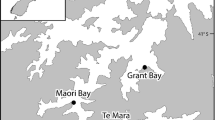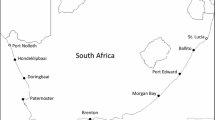Abstract
Habitat-forming, ecosystem engineer species are common in most marine systems. Still, much uncertainty exists about how individual and population-level traits of these species contribute to ecosystem processes and how engineering species jointly affect biodiversity. In this manipulative field experiment, we examined how biodiversity in marginal blue mussel beds is affected by blue mussel (1) body size, density and patch context and (2) presence of fucoid and algal structures. In the study area, bladder-wrack (Fucus vesiculosus), filamentous algae and blue mussels (Mytilus edulis) coexist at shallow depths in a variety of patch configurations and offer complex habitats with a high variability of resources. We hypothesized that complexity in terms of mussel bed structure and algal presence determines species composition and abundance. Results from the experiment were compared with macrofaunal communities found in natural populations of both engineering species. Results show that the physical structure and blue mussel patch context are important determinants for species composition and abundance. Results further show that the presence of algal structures positively affects diversity in blue mussel habitats due to increased surface availability and complexity that these algae offer. This study shows that blue mussel beds at the very margin of their distribution have an indisputable function for promoting and maintaining biodiversity and suggest that facilitative effects of habitat-modifying species are important on Baltic Sea rocky shores with fundamental importance to community structure.






Similar content being viewed by others
References
Badano EI, Marquet PA (2008) Ecosystem engineering affects ecosystem functioning in high-Andean landscapes. Oecologia 155:821–829
Bazzaz FA (1975) Plant species diversity in old-field successional ecosystems in southern Illinois. Ecology 56:485–488
Bick A, Zettler ML (1994) The distribution of Hydrobiids and the effects of sediment characteristics on the population dynamics of Hydrobia ventrosa in a coastal region of the southern Baltic. Int Revue Hydrobiol 79(3):325–336
Bruno JF, Bertness MD (2000) Habitat modification and facilitation in benthic marine communities. In: Bertness MD, Gaines SD, Hay ME (eds) Marine community ecology. Sinauer Associates Inc, Massachusetts, pp 201–218
Bruno JF, Kennedy CW (2000) Patch-size dependent habitat modification and facilitation on New England cobble beaches by Spartina alterniflora. Oecologia 122:98–108
Castilla JC, Lagos NA, Cerda M (2004) Marine ecosystem engineering by the alien ascidian Pyura praeputialis on a mid-intertidal rocky shore. Mar Ecol Prog Ser 268:119–130
Chapman MG, People J, Blockley D (2005) Intertidal assemblages associated with natural Corallina turf and invasive mussel beds on seawalls. Biodivers Conserv 14:1761–1776
Clarke KR, Somerfield PR, Chapman MG (2006) On resemblance measures for ecological studies, including taxonomic dissimilarities and a zero-adjusted Bray-Curtis coefficient for denuded assemblages. J Exp Mar Biol Ecol 330:55–80
Cole VJ (2009) Densities of polychaetes in habitat fragments depend on the surrounding matrix but not the complexity of the remaining fragment. Austral Ecol 34:469–477
Commito JA, Boncavage EM (1989) Suspension-feeders and coexisting infauna: An enhancement counter-example. J Exp Mar Biol Ecol 125:33–42
Commito JA, Celano EA, Celico HJ, Como S, Johnson CP (2005) Mussels matter: postlarval dispersal dynamics altered by a spatially complex ecosystem engineer. J Exp Mar Biol Ecol 316:133–147
Crooks JA, Khim HS (1999) Architectural vs. biological effects of a habitat-altering exotic mussel, Musculista senhousia. J Exp Mar Biol Ecol 240:53–75
Duffy JE, Hay ME (1991) Food and shelter as determinants of food choice by an herbivorous marine amphipod. Ecology 72:1286–1298
Fonseca MS, Kenworthy WJ, Colby DR, Rittmaster KA, Thayer GW (1990) Comparison of fauna among transplanted eelgrass Zostera marina meadows: criteria for mitigation. Mar Ecol Prog Ser 65:251–264
Gaston KJ (2003) The structure and dynamics of geographic ranges. Oxford University Press, Oxford
Gee JM, Warwick RM (1994) Metazoan community structure in relation to the fractal dimensions of marine macroalgae. Mar Ecol Prog Ser 103:141–150
Hawkins AJS, Navarro E, Iglesias JIP (1990) Comparative allometrics of gut-passage time, gut content and metabolic faecal loss in Mytilus edulis and Cerastoderma edule. Mar Biol 105:197–204
Jelbart JE, Ross PM, Connolly RM (2006) Edge effects and patch size in seagrass landscapes: an experimental test using fish. Mar Ecol Prog Ser 319:93–102
Jones CG, Lawton JH, Shachak M (1994) Organisms as ecosystem engineers. Oikos 69:373–386
Jormalainen V, Ramsay T (2009) Resistance of the brown alga Fucus vesiculosus to herbivory. Oikos 5:713–722
Kangas P, Autio H, Hällfors G, Luther H, Niemi Å, Salemaa H (1982) A general model of the decline of Fucus vesiculosus at Tvärminne, south coast of Finland in 1977–81. Acta Bot Fenn 118:2–4, 12–17
Kautsky N, Wallentinus T (1980) Nutrient release from a Baltic Mytilus-red algal community and its role in benthic and pelagic productivity. Ophelia Suppl 1:17–30
Kautsky H, Kautsky L, Kautsky N, Kautsky U, Lindblad C (1992) Studies on the Fucus vesiculosus community in the Baltic Sea. Acta Pharm Suec 78:33–48
Kelaher BP (2003) Changes in habitat complexity negatively affect diverse gastropod assemblages in coralline algal turf. Oecologia 135:431–441
Kiirikki M (1996a) Mechanisms affecting macroalgal zonation in the northern Baltic Sea. Eur J Phycol 31:225–232
Kiirikki M (1996b) Experimental evidence that Fucus vesiculosus (Phaeophyta) controls filamentous algae by means of the whiplash effect. Eur J Phycol 31:61–66
Kiirikki M, Lehvo A (1997) Life strategies of filamentous algae in the northern Baltic Proper. Sarsia 82:259–267
Kiirikki M, Ruuskanen A (2000) Does fluctuating salinity induce branching of Fucus vesiculosus? Hydrobiologia 426:169–172
Kraufvelin P, Salovius S (2004) Animal biodiversity in Baltic rocky shore macroalgae: Can Cladophora glomerata compensate for lost Fucus vesiculosus? Estuar Coast Shelf Sci 61:369–378
Lilley SA, Schiel DR (2006) Community effects following the deletion of a habitat-forming alga from rocky marine shores. Oecologia 148:672–681
Littorin B, Gilek M (1999) A photographic study of the recolonization of cleared patches in a dense population of Mytilus edulis in the northern Baltic proper. Hydrobiologia 393:211–219
Miyamoto Y, Noda T (2004) Effects of mussels on competitively inferior species: competitive exclusion to facilitation. Mar Ecol Prog Ser 276:293–298
Mori AS, Komiyama A (2008) Differential survival among life stages contributes to co dominance of Abies mariesii and Abies veitchii in a sub-alpine old-growth forest. J Veg Sci 19:239–244
Norling P, Kautsky N (2007) Structural and functional effects of Mytilus edulis on diversity of associated species and ecosystem functioning. Mar Ecol Prog Ser 351:163–175
Norling P, Kautsky N (2008) Patches of the mussel Mytilus sp. are islands of high biodiversity in subtidal sediment habitats in the Baltic Sea. Aquat Biol 4:75–87
Ólafsson EB (1986) Density dependence in suspension-feeding and deposit-feeding populations of the bivalve Macoma balthica: a field experiment. J Anim Ecol 55:517–526
Omstedt A, Hansson D (2006) The Baltic Sea ocean climate system memory and response to changes in the water and heat balance components. Cont Shelf Res 26:236–251
Palomo MG, People J, Chapman MG, Underwood AJ (2007) Separating the effects of physical and biological aspects of mussel beds on their associated assemblages. Mar Ecol Prog Ser 344:131–142
Pearson TH, Rosenberg R (1987) Feast and famine: structuring factors in marine benthic communities. In: Gee JHR, Giller PS (eds) Organization of communities past and present. Blackwell Scientific Publications, Oxford, pp 373–395
Pianka ER (1988) Evolutionary ecology. Harper and Row, New York
Råberg S, Kautsky L (2007) A comparative biodiversity study of the associated fauna of perennial fucoids and filamentous algae. Estuar Coast Shelf Sci 73:249–258
Root RB (1967) The niche exploitation pattern of the blue-gray gnatcatcher. Ecol Monogr 37:317–350
Snoeijs PJM, Kautsky U (1989) Effects of Ice-break on the Structure and Dynamics of a Benthic Diatom Community in the Northern Baltic Sea. Bot Mar 32:547–562
Snover ML, Commito JA (1998) The fractal geometry of Mytilus edulis spatial distribution in a soft-bottom system. J Exp Mar Biol Ecol 223:53–64
Stachowicz JJ (2001) Mutualism, facilitation, and the structure of ecological communities. Bioscience 51:235–246
Suchanek TH (1980) Diversity in natural and artificial mussel bed communities of Mytilus californianus. Am Zool 20:807
Thiel M, Ullrich N (2002) Hard rock versus soft bottom: the fauna associated with intertidal mussel beds on hard bottoms along the coast of Chile, and considerations on the functional role of mussel beds. Helgol Mar Res 56:21–30
Travis JM (2004) A method for simulating patterns of habitat availability at static and dynamic range margins. Oikos 104:410–416
Tsuchiya M, Nishihira M (1985) Islands of Mytilus as a habitat for small intertidal animals: effect of island size on community structure. Mar Ecol Prog Ser 25:71–81
Tsuchiya M, Nishihira M (1986) Islands of Mytilus edulis as a habitat for small intertidal animals: effect of Mytilus age structure on the species composition of the associated fauna and community organization. Mar Ecol Prog Ser 31:171–178
Westerbom M, Jattu S (2006) Effects of wave exposure on the sublittoral distribution of blue mussels Mytilus edulis in a heterogeneous archipelago. Mar Ecol Prog Ser 306:191–200
Westerbom M, Kilpi M, Mustonen O (2002) Blue mussels, Mytilus edulis, at the edge of the range: population structure, growth and biomass along a salinity gradient in the north-eastern Baltic Sea. Mar Biol 140(5):991–999
Westerbom M, Mustonen O, Kilpi M (2008) Distribution of a marginal population of Mytilus edulis: responses to biotic and abiotic processes at different spatial scales. Mar Biol 153:1153–1164
Wikström SA, Kautsky L (2007) Structure and diversity of invertebrate communities in the presence and absence of canopy-forming Fucus vesiculosus in the Baltic Sea. Estuar Coast Shelf Sci 72(1–2):168–176
Wright JP, Jones CG (2006) The concept of organisms as ecosystem engineers 10 years on: progress, limitations, and challenges. Bioscience 56:203–209
Yakovis EL, Artemieva AV, Shunatova NN, Varfolomeeva MA (2008) Multiple foundation species shape benthic habitat islands. Oecologia 155:785–795
Acknowledgments
We would like to thank the staff at Tvärminne Zoological Station for all the help with equipment, material and accommodation. This research is part of M.K’s PhD project supported by Onni Talaan Säätiö. Walter and Andree de Nottbeck Foundation (M.K, M.W) and the Academy of Finland (project nr 126831, M.W) are acknowledged for financial support. The contribution of two anonymous reviewers clarifying a previous draft and of two additional reviewers for a revised version is highly appreciated. The study complies with current laws in Finland.
Author information
Authors and Affiliations
Corresponding author
Additional information
Communicated by P. Kraufvelin.
Rights and permissions
About this article
Cite this article
Koivisto, M.E., Westerbom, M. Habitat structure and complexity as determinants of biodiversity in blue mussel beds on sublittoral rocky shores. Mar Biol 157, 1463–1474 (2010). https://doi.org/10.1007/s00227-010-1421-9
Received:
Accepted:
Published:
Issue Date:
DOI: https://doi.org/10.1007/s00227-010-1421-9




